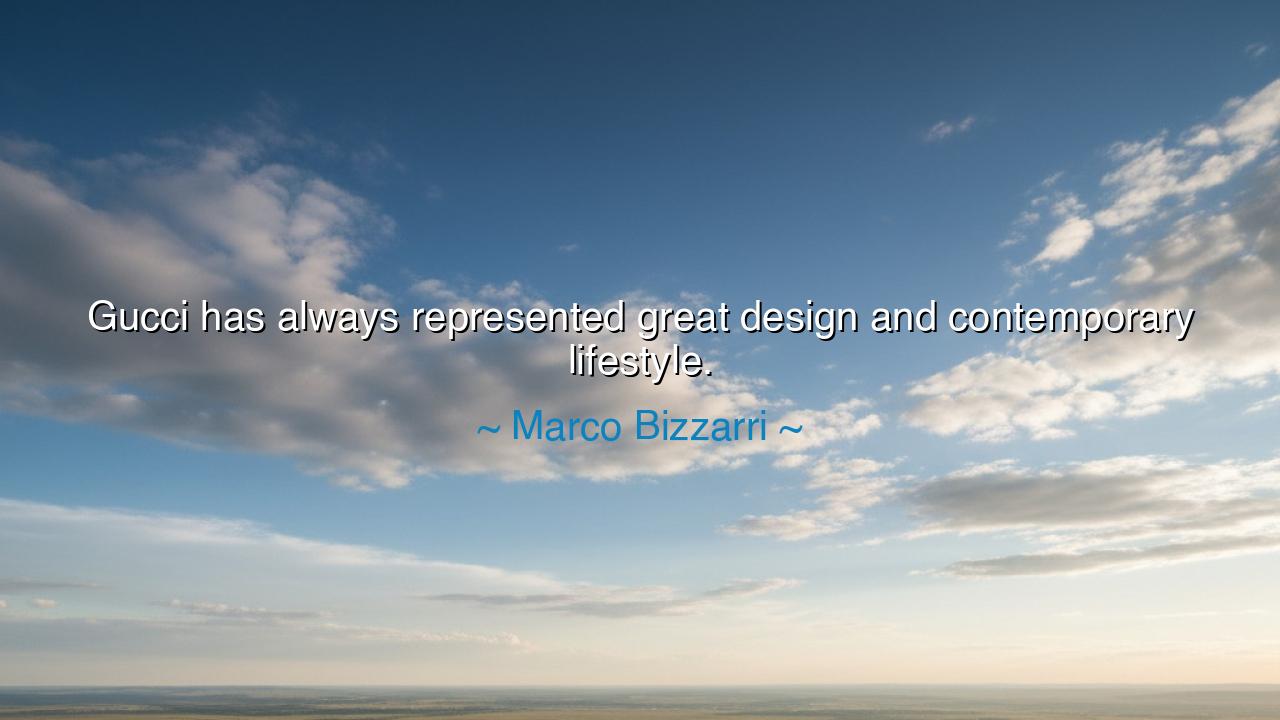
Gucci has always represented great design and contemporary






“Gucci has always represented great design and contemporary lifestyle.” Thus spoke Marco Bizzarri, steward of one of the world’s most iconic houses of fashion, and his words, though simple in form, are rich with meaning. For in this statement lies the story not only of a brand, but of a philosophy—the eternal dialogue between tradition and innovation, between the heritage of craftsmanship and the pulse of modern life. Bizzarri’s words are a declaration of continuity, of how something born in the past can remain alive in the present—not as a relic, but as a living symbol of design, identity, and change.
The house of Gucci, founded in 1921 by Guccio Gucci, began not as an empire, but as a humble workshop in Florence. Its founder, inspired by the luggage he saw carried by aristocrats in London hotels, sought to create objects that blended elegance with function, beauty with endurance. His designs were crafted by hand, stitched with precision and pride—works of art that bore not only the name of Gucci, but the spirit of Italy itself. Over the decades, the house grew, survived wars and rivalries, and emerged as a beacon of luxury and innovation. Each generation of designers added their own vision, yet the essence remained: Gucci was not merely about clothing or accessories—it was about design as a way of life, a reflection of how art can shape the modern soul.
When Bizzarri speaks of “great design,” he does not speak only of aesthetics. To him, and to those who walk the creative path, design is the union of purpose and emotion—the art of giving form to human experience. A chair, a garment, a building—all may be designed—but only when infused with meaning do they rise to greatness. Great design is not decoration; it is communication. It tells a story, expresses a truth, and binds beauty to intention. Thus, Gucci’s greatness lies not in ornament, but in its ability to express the zeitgeist, the living rhythm of its time, while remaining rooted in the enduring values of quality and imagination.
The phrase “contemporary lifestyle” in Bizzarri’s quote carries equal weight. It acknowledges that true design does not belong to the past—it must evolve, breathe, and adapt to the desires and dreams of the present. Each era brings its own challenges and ideals; each generation seeks to define what it means to live beautifully and meaningfully. Under Bizzarri’s leadership, and through the vision of creative minds like Alessandro Michele, Gucci became not just a fashion house, but a mirror reflecting the complexities of the modern age. It celebrated diversity, individuality, and rebellion—the courage to express oneself freely. In this, the brand transcended luxury and became cultural language, shaping how people imagine and inhabit the world.
Consider the rebirth of Gucci in the 21st century, when it faced decline and doubt. Many believed the flame had dimmed. Yet Bizzarri, with vision and humility, revived the house not by returning to old glories, but by redefining what luxury means in a changing world. He understood that design must evolve as the human spirit evolves. He embraced sustainability, inclusivity, and storytelling—values that resonated with a generation searching for meaning beyond wealth. Under his guidance, Gucci once again became not just a brand, but a movement—a living embodiment of the contemporary lifestyle that unites art, ethics, and emotion.
Yet beneath the grandeur of the name and the richness of its fabrics lies a lesson far greater than fashion. What Bizzarri teaches us is that legacy is not a weight to bear, but a foundation to build upon. To create something lasting, one must honor the past while daring to change it. The same principle applies to every soul: we are each born into traditions—of family, culture, or belief—but it is our task to carry them forward with new purpose. To live “contemporarily” is not to abandon what came before, but to infuse it with the life of the present.
Thus, let these words be a guide to all who create: whether you design garments, ideas, or destinies, strive for great design—for that union of thought and feeling that gives permanence to the fleeting. And live a contemporary lifestyle, not one of trends and indulgence, but of awareness—of being alive to your own time, awake to its beauty and its needs. Do not build walls between what was and what is; instead, design bridges that connect them.
For the wise know, as Marco Bizzarri reminds us, that the highest art is not to preserve the past untouched, nor to chase the future unmoored—but to weave them together into something whole. That is what Gucci has done through every age. And that is what each of us must do in our own way—to live as artists of the present, crafting our lives as the ultimate design, under the eternal canvas of time.






AAdministratorAdministrator
Welcome, honored guests. Please leave a comment, we will respond soon